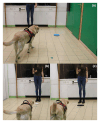Cognitive and sensory capacity each contribute to the canine spatial bias
- PMID: 38434251
- PMCID: PMC7615695
- DOI: 10.1111/eth.13423
Cognitive and sensory capacity each contribute to the canine spatial bias
Abstract
Dogs interpret cues as being about location, which human infants would relate to objects. This spatial bias could shed light on the evolution of object-centered thought, however, research needs to rule out that this is not a by-product of dogs' weaker (compared to humans) visual capacities. In this study, we used a data set in which dogs were tested in two types of learning tasks (discrimination and reversal learning) with two types of rewarded cues (location and object features). In both tasks, dogs displayed spatial bias, that is, faster learning when the rewarded cue was a location. We investigated how sensory and cognitive capacity each contributes to this spatial bias. To this end, an estimate for general cognitive ability (g) was obtained from a battery of tests for some of the dogs. Cephalic index, a feature targeted in breeding and linked to differences in visual capacity, correlated negatively with the expression of spatial bias only in the easier discrimination learning task, while a negative correlation between g factor and spatial bias scores emerged in the more difficult reversal learning task. We conclude that dogs' spatial bias cannot be reduced to a sensory limitation and is easier to overcome with greater cognitive capacity.
Keywords: cognition; dogs; spatial bias.
Conflict of interest statement
Conflict of Interest Statement The authors declare no conflict of interest.
Figures




Similar articles
-
Effect of age on discrimination learning, reversal learning, and cognitive bias in family dogs.Learn Behav. 2018 Dec;46(4):537-553. doi: 10.3758/s13420-018-0357-7. Learn Behav. 2018. PMID: 30251103 Free PMC article.
-
Association, inhibition, and object permanence in dogs' (Canis familiaris) spatial search.J Comp Psychol. 2011 May;125(2):194-206. doi: 10.1037/a0022584. J Comp Psychol. 2011. PMID: 21604853
-
Spatial generalization of imitation in dogs (Canis familiaris).J Comp Psychol. 2016 Aug;130(3):249-58. doi: 10.1037/com0000033. Epub 2016 Apr 28. J Comp Psychol. 2016. PMID: 27124400
-
Canine perspective-taking.Anim Cogn. 2023 Jan;26(1):275-298. doi: 10.1007/s10071-022-01736-z. Epub 2023 Jan 11. Anim Cogn. 2023. PMID: 36629935 Free PMC article. Review.
-
Spatial Navigation (Water Maze) Tasks.In: Buccafusco JJ, editor. Methods of Behavior Analysis in Neuroscience. 2nd edition. Boca Raton (FL): CRC Press/Taylor & Francis; 2009. Chapter 13. In: Buccafusco JJ, editor. Methods of Behavior Analysis in Neuroscience. 2nd edition. Boca Raton (FL): CRC Press/Taylor & Francis; 2009. Chapter 13. PMID: 21204326 Free Books & Documents. Review.
Cited by
-
Age-related effects on a hierarchical structure of canine cognition.Geroscience. 2024 Dec;46(6):5843-5874. doi: 10.1007/s11357-024-01123-1. Epub 2024 Mar 21. Geroscience. 2024. PMID: 38512580 Free PMC article.
-
The behavioural effect of short-term cognitive and physical intervention therapies in old dogs.Geroscience. 2024 Dec;46(6):5409-5429. doi: 10.1007/s11357-024-01122-2. Epub 2024 Apr 3. Geroscience. 2024. PMID: 38568435 Free PMC article.
-
Sound quality impacts dogs' ability to recognize and respond to playback words.Sci Rep. 2025 Apr 28;15(1):14175. doi: 10.1038/s41598-025-96824-8. Sci Rep. 2025. PMID: 40295562 Free PMC article.
References
-
- Bognár Z, Piotti P, Szabó D, le Nézet L, Kubinyi E. A novel behavioural approach to assess responsiveness to auditory and visual stimuli before cognitive testing in family dogs. Applied Animal Behaviour Science. 2020;228:105016. doi: 10.1016/j.applanim.2020.105016. - DOI
Grants and funding
LinkOut - more resources
Full Text Sources
